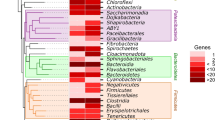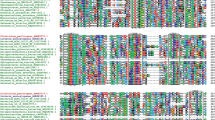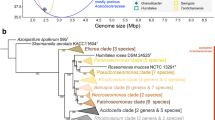Abstract
Over recent years, Alicyclobacillus acidocaldarius, a Gram-positive nonpathogenic rod-shaped thermo-acid-tolerant bacterium, has posed numerous challenges for the fruit juice industry. However, the bacterium’s unique characteristics, particularly its nonpathogenic and thermophilic capabilities, offer significant opportunities for genetic exploration by biotechnologists. This study presents the computational proteogenomics report on the carboxylesterase (CE) enzyme in A. acidocaldarius, shedding light on structural and evolutional of CEs from this bacterium. Our analysis revealed that the average molecular weight of CEs in A. acidocaldarius was 41 kDa, with an isoelectric point around 5. The amino acid composition favored negative amino acids over positive ones. The aliphatic index and hydropathicity were approximately 88 and − 0.15, respectively. While the protein sequence showed no disulfide bonds in the CEs’ structure, the presence of Cys amino acids was observed in the structure of CEs. Phylogenetic analysis presented more than 99% similarity between CEs, indicating their close evolutionary relationship. By applying homology modeling, the 3-dimensional structural models of the carboxylesterase were constructed, which with the help of structural conservation and solvent accessibility analysis highlighted key residues and regions responsible for enzyme stability and conformation. The specific patterns presented the total solvent accessibility of less than 25 (Å2) was in considerable position as well as Gly residues were noticeably have high accessibility to solvent in all structures. Ala was the more frequent amino acids in the conserved-SASA of carboxylesterases. Furthermore, unsupervised agglomerative hierarchical clustering based on solvent accessibility feature successfully clustered and even distinguished this enzyme from proteases from the same genome. These findings contribute to a deeper understanding of the nonpathogenic A. acidocaldarius carboxylesterase and its potential applications in biotechnology. Additionally, structural analysis of CEs would help to address potential solutions in fruit juice industry with utilization of computational structural biology.





Similar content being viewed by others
Data Availability
The datasets analysed during the current study are available from the corresponding author on reasonable request.
References
Akkaya A, Ensari Y, Ozseker EE, Batur OO, Buyuran G, Evran S (2023) Recombinant production and biochemical characterization of Thermostable Arabinofuranosidase from Acidothermophilic Alicyclobacillus Acidocaldarius. Protein J 42:437–450. https://doi.org/10.1007/s10930-023-10117-5
Akram F, Mir AS, Haq IU, Roohi A (2023) An appraisal on prominent industrial and biotechnological applications of bacterial lipases. Mol Biotechnol 65:521–543. https://doi.org/10.1007/s12033-022-00592-z
Aston JE, Apel WA, Lee BD, Thompson DN, Lacey JA, Newby DT, Reed DW, Thompson VS (2016) Degradation of phenolic compounds by the lignocellulose deconstructing thermoacidophilic bacterium Alicyclobacillus Acidocaldarius. J Ind Microbiol Biotechnol 43:13–23. https://doi.org/10.1007/s10295-015-1700-z
Baysal T, Taştan Ö (2022) Decontamination of Fruit Juices by Combination of High Intensity Pulsed Light and other Nonthermal technologies. In: REŽEK JAMBRAK A (ed) Nonthermal Processing in Agri-Food-Bio sciences: sustainability and future goals. Cham. Springer International Publishing, pp 639–653
Beck AE (2020) Metabolic efficiency of sugar co-metabolism and phenol degradation in Alicyclobacillus acidocaldarius for improved lignocellulose processing. 8:502. https://doi.org/10.3390/pr8050502
Bevilacqua A, Sinigaglia M, Corbo MR (2008) Alicyclobacillus acidoterrestris: new methods for inhibiting spore germination. Int J Food Microbiol 125:103–110. https://doi.org/10.1016/j.ijfoodmicro.2008.02.030
Bevilacqua A, Speranza B, Petruzzi L, Sinigaglia M, Corbo MR (2023) Using regression and multifactorial analysis of Variance to assess the effect of ascorbic, citric, and malic acids on spores and activated spores of Alicyclobacillus acidoterrestris. Food Microbiol 110:104158. https://doi.org/10.1016/j.fm.2022.104158
Borchert AJ, Henson WR, Beckham GT (2022) Challenges and opportunities in biological funneling of heterogeneous and toxic substrates beyond lignin. Curr Opin Biotechnol 73:1–13. https://doi.org/10.1016/j.copbio.2021.06.007
Chahinian H, Sarda L (2009) Distinction between esterases and lipases: comparative biochemical properties of sequence-related carboxylesterases. Protein Pept Lett 16:1149–1161. https://doi.org/10.2174/092986609789071333
Chowdhury R, Maranas C (2019) From directed evolution to computational enzyme engineering – a review. AICHE J 66:e16847. https://doi.org/10.1002/aic.16847
Ciuffreda E, Bevilacqua A, Sinigaglia M, Corbo MR (2015) Alicyclobacillus spp.: new insights on ecology and preserving food quality through new approaches. Microorganisms 3:625–640. https://doi.org/10.3390/microorganisms3040625
Corpet F (1988) Multiple sequence alignment with hierarchical clustering. Nucleic Acids Res 16:10881–10890. https://doi.org/10.1093/nar/16.22.10881
Dolinsky VW, Gilham D, Alam M, Vance D, Lehner R (2004) Triacylglycerol hydrolase: role in intracellular lipid metabolism. Cell Mol Life Sci 61:1633–1651. https://doi.org/10.1007/s00018-004-3426-3
Febbraio F, D’andrea SE, Mandrich L, Merone L, Rossi M, Nucci R, Manco G (2008) Irreversible inhibition of the thermophilic esterase EST2 from Alicyclobacillus acidocaldarius. Extremophiles 12:719–728. https://doi.org/10.1007/s00792-008-0179-1
Fraczkiewicz R, Braun W (1998) Exact and efficient analytical calculation of the accessible surface areas and their gradients for macromolecules. J Comput Chem 19:319–333. https://doi.org/10.1002/(SICI)1096-987X(199802)19:3<319::AID-JCC6>3.0.CO;2-W
Gasteiger E, Hoogland C, Gattiker A, Duvaud SE, Wilkins MR, Appel RD, Bairoch A (2005) Protein identification and analysis tools on the ExPASy server. Springer
Ghodke VM, Punekar NS (2022) Environmental role of aromatic carboxylesterases. Environ Microbiol 24:2657–2668. https://doi.org/10.1111/1462-2920.15774
Groenewald WH, Gouws PA, Witthuhn RC (2009) Isolation, identification and typification of Alicyclobacillus acidoterrestris and Alicyclobacillus acidocaldarius strains from orchard soil and the fruit processing environment in South Africa. Food Microbiol 26:71–76. https://doi.org/10.1016/j.fm.2008.07.008
Guan N, Liu L (2020) Microbial response to acid stress: mechanisms and applications. Appl Microbiol Biotechnol 104:51–65. https://doi.org/10.1007/s00253-019-10226-1
Kate A, Sahu LK, Pandey J, Mishra M, Sharma PK (2022) Green catalysis for chemical transformation: the need for the sustainable development. Curr Opin Green Sustain Chem 5:100248. https://doi.org/10.1016/j.crgsc.2021.100248
Koranian P, Huang Q, Dalai AK, Sammynaiken R (2022) Chemicals production from glycerol through heterogeneous catalysis: a review. Catalysts 12:897. https://doi.org/10.3390/catal12080897
Kumar TA (2013) CFSSP: Chou and Fasman secondary structure prediction server. Wide Spectr 1:15–19
Luong TSV, Moir C, Bowman JP, Chandry PS (2021) Heat resistance and genomics of spoilage Alicyclobacillus Spp. Isolated from fruit juice and fruit-based beverages. Food Microbiol 94:103662. https://doi.org/10.1016/j.fm.2020.103662
Madeira F, Pearce M, Tivey ARN, Basutkar P, Lee J, Edbali O, Madhusoodanan N, Kolesnikov A, Lopez R (2022) Search and sequence analysis tools services from EMBL-EBI in 2022. Nucleic Acids Res 50:W276–W279. https://doi.org/10.1093/nar/gkac240
Maghraby YR, El-Shabasy RM, Ibrahim AH, Azzazy HME-S (2023) Enzyme immobilization technologies and industrial applications. ACS Omega 8:5184–5196. https://doi.org/10.1021/acsomega.2c07560
Magnusson AO, Rotticci-Mulder JC, Santagostino A, Hult K (2005) Creating space for large secondary alcohols by rational redesign of Candida Antarctica lipase B. ChemBioChem 6:1051–1056. https://doi.org/10.1002/cbic.200400410
Manco G, Di Gennaro S, De Rosa M, Rossi M (1994) Purification and characterization of a thermostable carboxylesterase from the thermoacidophilic eubacterium bacillus acidocaldarius. Eur J Biochem 221. https://doi.org/10.1111/j.1432-1033.1994.tb18812.x. :965–72
Manco G, Adinolfi E, Pisani FM, Ottolina G, Carrea G, Rossi M (1998) Overexpression and properties of a new thermophilic and thermostable esterase from Bacillus acidocaldarius with sequence similarity to hormone-sensitive lipase subfamily. Biochem J 332(Pt 1):203–212. https://doi.org/10.1042/bj3320203
Manco G, Carrea G, Giosuè E, Ottolina G, Adamo G, Rossi M (2002) Modification of the enantioselectivity of two homologous thermophilic carboxylesterases from Alicyclobacillus acidocaldarius and Archaeoglobus fulgidus by random mutagenesis and screening. Extremophiles 6:325–331. https://doi.org/10.1007/s00792-001-0261-4
Mandrich L, Manco G, Rossi M, Floris E, Jansen-Van Den Bosch T, Smit G, Wouters JA (2006) Alicyclobacillus acidocaldarius thermophilic esterase EST2’s activity in milk and cheese models. Appl Environ Microbiol 72:3191–3197. https://doi.org/10.1128/aem.72.5.3191-3197.2006
Mandrich L, Menchise V, Alterio V, De Simone G, Pedone C, Rossi M, Manco G (2008) Functional and structural features of the oxyanion hole in a thermophilic esterase from Alicyclobacillus acidocaldarius. Proteins 71:1721–1731. https://doi.org/10.1002/prot.21877
Mandrich L, Merone L, Manco G (2009) Structural and kinetic overview of the carboxylesterase EST2 from Alicyclobacillus acidocaldarius: a comparison with the other members of the HSL family. Protein Pept Lett 16:1189–1200. https://doi.org/10.2174/092986609789071261
Meghwanshi GK, Verma S, Srivastava V, Kumar R (2022) Archaeal lipolytic enzymes: current developments and further prospects. Biotechnol Adv 61:108054. https://doi.org/10.1016/j.biotechadv.2022.108054
Meyer J, Meyer LE, Kara S (2022) Enzyme immobilization in hydrogels: a perfect liaison for efficient and sustainable biocatalysis. Eng Life Sci 22:165–177. https://doi.org/10.1002/elsc.202100087
Nagaroor V, Gummadi SN (2022) An overview of mammalian and microbial hormone-sensitive lipases (lipolytic family IV): biochemical properties and industrial applications. Biotechnol Genet Eng Rev 1–30. https://doi.org/10.1080/02648725.2022.2127071
Narayanan M, Ali SS, El-Sheekh M (2023) A comprehensive review on the potential of microbial enzymes in multipollutant bioremediation: mechanisms, challenges, and future prospects. J Environ Manage 334:117532. https://doi.org/10.1016/j.jenvman.2023.117532
Nazarian Z, Arab SS (2022) Discovery of carboxylesterases via metagenomics: putative enzymes that contribute to chemical kinetic resolution. Process Biochem 121:439–454. https://doi.org/10.1016/j.procbio.2022.07.025
Nezhad NG, Rahman RNZRA, Normi YM, Oslan SN, Shariff FM, Leow TC (2022) Thermostability engineering of industrial enzymes through structure modification. Appl Microbiol Biotechnol 106:4845–4866. https://doi.org/10.1007/s00253-022-12067-x
Ortiz-Cortés LY, Ventura-Canseco LMC, Abud-Archila M, Ruíz-Valdiviezo VM, Velázquez-Ríos IO, Alvarez-Gutiérrez PE (2021) Evaluation of temperature, pH and nutrient conditions in bacterial growth and extracellular hydrolytic activities of two Alicyclobacillus spp. strains. Arch Microbiol 203:4557–4570. https://doi.org/10.1007/s00203-021-02332-4
Pahalagedara ASNW, Gkogka E, Ravn LW, Hammershøj M (2023) The growth potential and thermal resistance of bacterial spores under conditions relevant for ambient acid dairy-based products. Food Control 152:109841. https://doi.org/10.1016/j.foodcont.2023.109841
Pettersen EF, Goddard TD, Huang CC, Couch GS, Greenblatt DM, Meng EC, Ferrin TE (2004) UCSF Chimera—a visualization system for exploratory research and analysis. J Comput Chem 25:1605–1612. https://doi.org/10.1002/jcc.20084
Pornpukdeewattana S, Jindaprasert A, Massa S (2020) Alicyclobacillus spoilage and control-a review. Crit Rev Food Sci Nutr 60:108–122. https://doi.org/10.1080/10408398.2018.1516190
Prado DBD, Szczerepa MMDA, Capeloto OA, Astrath NGC, Santos NCD, Previdelli ITS, Nakamura CV, Mikcha JMG, Abreu Filho BaD (2019) Effect of ultraviolet (UV-C) radiation on spores and biofilms of Alicyclobacillus spp. in industrialized orange juice. Int J Food Microbiol 305:108238. https://doi.org/10.1016/j.ijfoodmicro.2019.108238
Priyadarshini P, Singh B (2019) Chap. 16 - computational resources and techniques in enzyme research. In: SINGH RS, PANDEY SINGHANIARR, A., LARROCHE C (eds) Advances in enzyme technology. Elsevier, pp 453–468
Quiroga AD, Lehner R (2011) Role of endoplasmic reticulum Neutral lipid hydrolases. Trends Endocrinol Metab 22:218–225. https://doi.org/10.1016/j.tem.2011.03.003
Rafeeq H, Hussain A, Shabbir S, Ali S, Bilal M, Sher F, Iqbal HM (2022) Esterases as emerging biocatalysts: mechanistic insights, genomic and metagenomic, immobilization, and biotechnological applications. Biotechnol Appl Biochem 69:2176–2194. https://doi.org/10.1002/bab.2277
Raina D, Kumar V, Saran S (2022) A critical review on exploitation of agro-industrial biomass as substrates for the therapeutic microbial enzymes production and implemented protein purification techniques. Chemosphere 294:133712. https://doi.org/10.1016/j.chemosphere.2022.133712
Rost B, Sander C (1994) Conservation and prediction of solvent accessibility in protein families. Proteins Struct Funct Genet 20:216–226. https://doi.org/10.1002/prot.340200303
Rotticci D, Rotticci-Mulder JC, Denman S, Norin T, Hult K (2001) Improved enantioselectivity of a lipase by rational protein engineering. ChemBioChem 2:766–70. https://doi.org/10.1002/1439-7633(20011001)2:10<766::AID-CBIC766>3.0.CO;2-K.
Sarmah N, Revathi D, Sheelu G, Yamuna Rani K, Sridhar S, Mehtab V, Sumana C (2018) Recent advances on sources and industrial applications of lipases. Biotechnol Prog 34:5–28. https://doi.org/10.1002/btpr.2581
Satheesh Kumar G, Chandra MS, Mallaiah KV, Sreenivasulu P, Choi Y-L (2010) Purification and characterization of highly thermostable α-amylase from thermophilic Alicyclobacillus acidocaldarius. Biotechnol Bioprocess Eng 15:435–440. https://doi.org/10.1007/s12257-009-0072-5
Satoh T, Hosokawa M (2006) Structure, function and regulation of carboxylesterases. Chem Biol Interact 162:195–211. https://doi.org/10.1016/j.cbi.2006.07.001
Satoh T, Hosokawa M (2009) Carboxylesterases: structure, function and polymorphism. Biomol Ther (Seoul) 17:335–347. https://doi.org/10.4062/biomolther.2009.17.4.335
Siedenburg G, Jendrossek D (2011) Squalene-hopene cyclases. Appl Environ Microbiol 77:3905–3915. https://doi.org/10.1128/aem.00300-11
Silva Amatto VD, Gonsales Da Rosa-Garzon I, Antonio N, De Oliveira Simoes F, Santiago F, Pereira Da Silva Leite N, Raspante Martins J, Cabral H (2022) Enzyme engineering and its industrial applications. Biotechnol Appl Biochem 69:389–409. https://doi.org/10.1002/bab.2117
Smit Y, Cameron M, Venter P, Witthuhn RC (2011) Alicyclobacillus spoilage and isolation–a review. Food Microbiol 28:331–349. https://doi.org/10.1016/j.fm.2010.11.008
Sood S, Sharma A, Sharma N, Kanwar S (2016) Carboxylesterases: sources, characterization and broader applications. Insights in Enzyme Research 1:1–11. https://doi.org/10.21767/2573-4466.100002
Sourri P, Tassou CC, Nychas G-JE, Panagou EZ (2022) Fruit juice spoilage by Alicyclobacillus: detection and control methods—a comprehensive review. Foods 11:747. https://doi.org/10.3390/foods11050747
Sraphet S, Javadi B (2020) In silico analysis of Pseudomonas cellulose synthase A. Plant Cell Biotechnol Mol Biol 21:83–94
Sraphet S, Javadi B (2021) Computational characterizations of GDP-mannose 4, 6-dehydratase (NoeL) rhizobial proteins. Curr Genet 67:769–784. https://doi.org/10.1007/s00294-021-01184-1
Sraphet S, Javadi B (2022) Application of hierarchical clustering to analyze solvent-accessible surface area patterns in Amycolatopsis lipases. Biology 11:652. https://doi.org/10.3390/biology11050652
Steyn CE, Cameron M, Witthuhn RC (2011) Occurrence of Alicyclobacillus in the fruit processing environment—a review. Int J Food Microbiol 147:1–11. https://doi.org/10.1016/j.ijfoodmicro.2011.03.004
Tamura K, Stecher G, Kumar S (2021) MEGA11: Molecular Evolutionary Genetics Analysis Version 11. Mol Biol Evol 38:3022–3027. https://doi.org/10.1093/molbev/msab120
Tianli Y, Jiangbo Z, Yahong Y (2014) Spoilage by Alicyclobacillus bacteria in juice and beverage products: chemical, physical, and combined control methods. Compr Rev Food Sci Food Saf 13:771–797. https://doi.org/10.1111/1541-4337.12093
Van Luong TS, Moir CJ, Kaur M, Frank D, Bowman JP, Bradbury MI (2019) Diversity and guaiacol production of Alicyclobacillus spp. from fruit juice and fruit-based beverages. Int J Food Microbiol 311:108314. https://doi.org/10.1016/j.ijfoodmicro.2019.108314
Walker M, Phillips CA (2008) Alicyclobacillus acidoterrestris: an increasing threat to the fruit juice industry? Int J Food Sci Tech 43:250–260. https://doi.org/10.1111/j.1365-2621.2006.01427.x
Yang J, Anishchenko I, Park H, Peng Z, Ovchinnikov S, Baker D (2020) Improved protein structure prediction using predicted interresidue orientations. Proc Natl Acad Sci USA 117:1496–1503. https://doi.org/10.1073/pnas.1914677117
Yu CS, Lin CJ, Hwang JK (2004) Predicting subcellular localization of proteins for Gram-negative bacteria by support vector machines based on n‐peptide compositions. Protein Sci 13:1402–1406. https://doi.org/10.1110/ps.03479604
Yu CS, Chen YC, Lu CH, Hwang JK (2006) Prediction of protein subcellular localization. Proteins Struct Funct Genet 64:643–651. https://doi.org/10.1002/prot.21018
Acknowledgements
The authors would like to thank the Faculty of Science and Technology, Suan Sunandha Rajabhat University and Mahidol University, Thailand.
Funding
This research project was supported by Mahidol University, Basic Research Fund: fiscal year 2022 (Grant no. BRF1-082/2565); and Suan Sunandha Rajabhat University (Grant no. งป11773/2566).
Author information
Authors and Affiliations
Contributions
S.S did the Conceptualization, Investigation and Methodology, Experiments; B.J did the Supervision, review and editing.
Corresponding author
Ethics declarations
Competing interests
The authors declare no competing interests.
Ethics approval
This article does not contain any studies with human participants or animals performed by any of the authors.
Additional information
Publisher’s Note
Springer Nature remains neutral with regard to jurisdictional claims in published maps and institutional affiliations.
Electronic supplementary material
Below is the link to the electronic supplementary material.
Rights and permissions
Springer Nature or its licensor (e.g. a society or other partner) holds exclusive rights to this article under a publishing agreement with the author(s) or other rightsholder(s); author self-archiving of the accepted manuscript version of this article is solely governed by the terms of such publishing agreement and applicable law.
About this article
Cite this article
Sraphet, S., Javadi, B. Computational analysis of carboxylesterase genes and proteins in non-pathogenic food bacterium Alicyclobacillus acidocaldarius: insights from proteogenomics. World J Microbiol Biotechnol 39, 348 (2023). https://doi.org/10.1007/s11274-023-03805-y
Received:
Accepted:
Published:
DOI: https://doi.org/10.1007/s11274-023-03805-y




